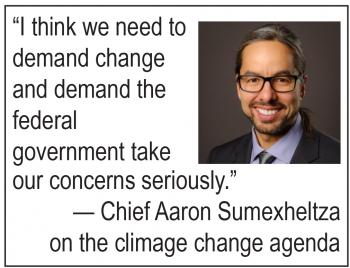Summary
The attendance of Assembly of First Nations chiefs at international meetings on climate change has not meant overwhelming influence by First Nations on the environmental and climate change agenda in Canada.
It wasn’t money wasted though to have National Chief Perry Bellegarde take a seat at the table as part of Canada’s delegation to the United Nations Framework Convention on Climate Change in Paris in 2015, or for Manitoba Regional Chief Kevin Hart to attend the 2016 climate change convention in Morocco. So says Chief Byron Louis of the Okanagan Indian Band.
“We need to be able to put our voices forward and say, ‘Hey, there is a very real cost to this.’”
But that doesn’t mean the AFN is doing enough to influence the agenda.
“I think the AFN can definitely do more, but leaders like myself can do more all across the country and we do need to sit down together, I believe, and figure out how we can work together to ensure that the federal government takes our concerns seriously,” said Chief Aaron Sumexheltza of the Lower Nicola Indian Band.
At the spring Special Chiefs Assembly for the AFN, both Louis and Sumexheltza signed their names to resolutions that focused on climate change and environment.
Louis, along with Skeetchestn Indian Band Chief Ron Ignace, introduced the resolution Addressing First Nations Rights, Title, and Jurisdiction in Bill C-69: Impact Assessment Act, Canadian Energy Regulator Act, and the Navigation Protection Act.
The resolution called for, in part, the AFN to advocate for joint decision making with the First Nations governing authorities and reducing “excessive Ministerial discretion.”
Sumexheltza and Chief Calvin Sanderson of the Chakastapaysin Band of the Cree Nation introduced a resolution on Bill C-74 to Develop First Nations-Specific Solutions for the Green House Gas Pollution Pricing Act.
The resolution called for, in part, the AFN to “pursue the commitment from Canada for the co-development of policies, regulations, and guidelines for the Carbon Levy and Output-Based Pricing Framework” respecting inherent rights, Treaties, title and jurisdiction, and recognizing First Nations inherent responsibilities to their traditional territories.
Of the nine resolutions put forward in May, three others focused on fisheries, also had climate change aspects. However, in July, the general assembly considered 30 resolutions and only two had cursory connections to climate change.
In 2016, the federal government drew up the Pan-Canadian Framework on Clean Growth and Climate Change, engaging the AFN, the Inuit Tapiriit Kanatami and the Métis National Council in separate discussion tables.
The purpose of the framework, with meetings that began in 2017, is, in part to “jointly develop real and meaningful approaches for Indigenous Peoples that position them as leaders of climate action, with clear timelines, objectives, and reporting in support of the (Pan-Canadian Framework) and other climate change activities,” according to the Environment and Climate Change Canada documentation.
However, Sumexheltza stresses that the AFN is not a First Nations government, but a lobby group, and any meaningful engagement with the federal government needs to happen with First Nations communities.
Some of that work is happening at the community level. The Mikisew Cree First Nation and Athabasca Chipewyan First Nation are working with a wildlife toxicologist in the oil sands region where the scientific expertise of Environment and Climate Change Canada is combining with Indigenous knowledge success to analyze the impacts of industrial contaminants on the health of wildlife.
On the Okanese First Nation, $125,000 from Crown-Indigenous Relations and Northern Affairs Canada is paying for four automated monitoring stations to track and allow the nation to adapt to climate change by developing an action plan to address climate change. The work is in partnership with the University of Saskatchewan department of geography and planning.
“I believe that when it comes to Indigenous people, in Canada … we’re at the brunt of a lot of the climate change issues … and we need to ensure that we’re involved and that our voice is heard moving forward,” said Sumexheltza.
One way for Indigenous people to have their voices heard, says Louis, is to put a price tag to their losses and bill government.
“One of the issues that will be coming up is the issue of damages. That’s probably one of the best ways we have to actually influence what’s actually happening in Canada,” he said.
He uses diet as an example. A survey of British Columbia’s Indigenous people shows they eat about 500 grams of salmon a day. Purchased at a grocery store, salmon runs about $9 per 500 grams. With B.C.’s Indigenous population set at 129,000 that’s a cost of over $500 million a year.
“You’re talking about some considerable numbers. Some of the best ways to actually influence that is when we go after damages,” said Louis, who adds the money would be claimed from both the federal government and B.C.
“They’re both guilty. They’re the ones who caused this, especially the provincial government that does not have the constitutional authority to be driving species into extinction. You’re talking about real damages.”
Louis wants to see First Nations develop their own socio-economic analysis models to measure the impacts of losses not only as food sources, but also for ceremonial use and for social use.
First Nations influence on climate change policies in Canada will not happen easily or quickly, says Louis.
“It’s going to be incremental because we never got here overnight and we’re not going to make the changes overnight,” he said.
And the arena to make those changes will be both nationally and internationally, and it will involve all First Nations peoples, says Sumexheltza.
“It’s not just the role of the AFN. It’s the obligation of First Nation leaders and community members across the country. We can’t rely solely on one organization to do all our work. We have to take ownership as leaders ourselves and do what we need to do,” he said.

